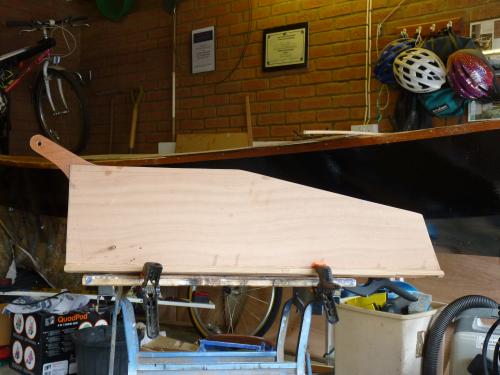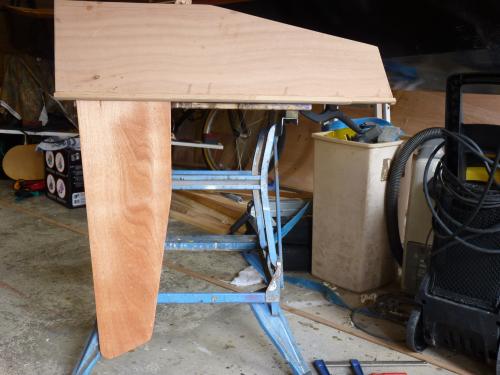Rudder Failure - builder error!
12
12

|
simplesimon |
Re: Rudder Failure - builder error!
|
|
A Mirror 10 (actually 11ft long) had a 12mm daggerboard IIRC Coypu (12ft long, jib & mainsail, very stable) centreboard is 15mm (and still children manage to break them if they're not glassed) Wayfarer centreboard is 18mm ply. (Never bothered to glass them) Simon |

|
Port-Na-Storm |
Re: Rudder Failure - builder error!
|
|
In reply to this post by Anders
I had the same dilemma when deciding whether Katie Beardie should have a centre board or dagger board.
The advantages and disadvantages are well known; Polythene Pam has a dagger board which is a fairly robust affair so its helpful to be able to remove it before heaving it onto the car roof, but it doesn't kick up when beaching so it has to be lifted out and then it clutters up the boat. Mirror Dinghy sailors will tell you how a raised dagger board will catch on kicking straps etc. at the most inconvenient moments.  So Katie is having a centreboard, its a low profile high aspect ratio kind of thing in an attempt to keep it low in the cockpit and still be fairly effective. This is a photo before i started butchering it yesterday. The horn had to go as the forward edge of the case is up against a bulkhead. The pivot point is low down and forward so that I get as much depth as possible as far forward as possible.  One thing you could think about; Some boats have centreboards which have a slot instead of a pivot hole. With a bit of wiggling they can be removed which might suit you for car topping. Cheers Graham |

|
Forthsailoar |
Re: Rudder Failure - builder error!
|
|
In reply to this post by alopenboat
For my Selway Fisher Waterman Open Canoe, rigged for sailing, I used a piece of pine plan I had lying around as the leeboard. Around 3/4inch I reckon. Plenty strong enough. And much lighter than plywood of same thickness.
All the best Osbert On Monday, 19 September 2011 at 19:55, alopenboat [via UK HBBR Forum] wrote:
|

|
Paul H (admin) |
Re: Rudder Failure - builder error!
|
|
In reply to this post by Port-Na-Storm
Grim,
What is the depth below the hull? Scaled up 25%-ish your case+board look about right for a Mirror ...more pics please! -Paul |

|
Port-Na-Storm |
Re: Rudder Failure - builder error!
|
|
The trick with the Mirror would be to end up with the centreboard in the same position as the dagger board when its down. How much space have you got between the leading edge of the board and the mast? Oh and that pesky kicking strap will be in there too, better change the rig to a balanced lug while you're at it.
 G |
|
|
In reply to this post by Forthsailoar
Generally a wide plank like this will be significantly stronger and stiffer than plywood for this application, as all the grain is running in the direction you need to take the loads. If you think about it, plywood is far from ideal for making centreboards or rudders, as these see pretty high bending loads and need pretty much all of their strength and stiffness in one axis. Jeremy |
|
|
James
Your description of the centerboard you made for your Coot sounds absolutely perfect and I would do so if I was going to use a trailer. But I´m going to cartop. so a centerboard like yours is to heavy. I like your idea of routing the edge and filling it with epoxy. Graham The Mirror has problems with its daggerboard because its sloop rigged. Cat rigged boats have a longer distance between mast and daggerboard case and so the daggerboard shouldnt interfere with the Kicker. (another vote down for the mirror rig  ) )
If making a centerboard out of solid spruce (strong and light) and sheating it with a strong cloth. Would 12 - 15mm be strong enough? or should it be 18mm? I´m talking about laminating a lot of sticks to make the plank in order to avoid wobling. I think the reason for using plywood for boards is mainly because its more stable and also easyer to work. Btw, we are talking about plywood as one kind of board. I think there´s no doubt that stronger plywood like birch will make a stronger board than weaker plywood such as okume/gaboon Well... still thinking. 
|
«
Return to General Discussion
|
1 view|%1 views
| Free forum by Nabble | Edit this page |
